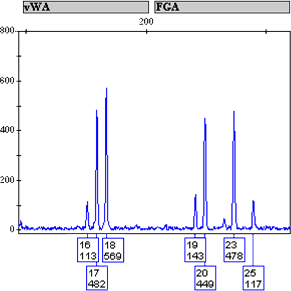Archival Notice
This is an archive page that is no longer being updated. It may contain outdated information and links may no longer function as originally intended.
Home | Glossary | Resources | Help | Contact Us | Course Map
The presence of major and minor contributor(s) is distinguishable when samples display alleles that have distinct contrast in signal intensities. All loci should be used for this evaluation, and laboratories should follow established procedures that are based upon validation studies.
See the YouTube Terms of Service and Google Privacy Policy
The calculations of peak height/area percentages and percent contribution of donors can be used to support the declaration or a major and/or minor contributor.
In these instances, the DNA profile of the major source may be easily determined at unambiguous loci.
In general, determining the DNA profile of the major contributor is easier than determining that of the minor source.
The set of peaks on the right (FGA locus) represent a clear major and minor contributor: there are two tall peaks and two short peaks.
The major contributor appears to be a 17, 18. It is unclear, however, whether the major contributor is or is not masking the minor contributor, who could be a 16, 16; a 16, 17; a 16, 18; or a 16, --- (where --- means the sister allele dropped out due to stochastic effects.
Additional Online Courses
- What Every First Responding Officer Should Know About DNA Evidence
- Collecting DNA Evidence at Property Crime Scenes
- DNA – A Prosecutor’s Practice Notebook
- Crime Scene and DNA Basics
- Laboratory Safety Programs
- DNA Amplification
- Population Genetics and Statistics
- Non-STR DNA Markers: SNPs, Y-STRs, LCN and mtDNA
- Firearms Examiner Training
- Forensic DNA Education for Law Enforcement Decisionmakers
- What Every Investigator and Evidence Technician Should Know About DNA Evidence
- Principles of Forensic DNA for Officers of the Court
- Law 101: Legal Guide for the Forensic Expert
- Laboratory Orientation and Testing of Body Fluids and Tissues
- DNA Extraction and Quantitation
- STR Data Analysis and Interpretation
- Communication Skills, Report Writing, and Courtroom Testimony
- Español for Law Enforcement
- Amplified DNA Product Separation for Forensic Analysts


